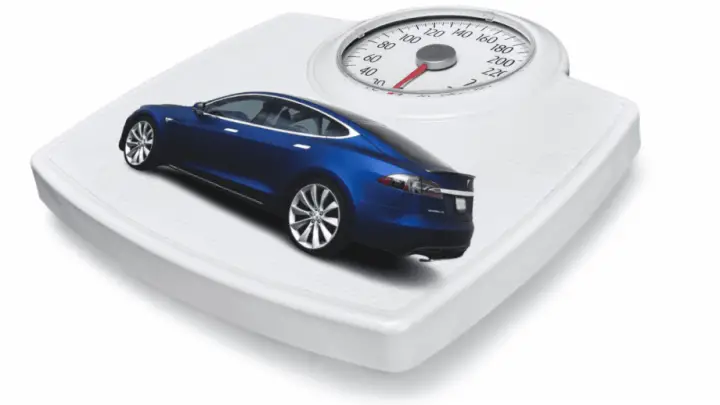How Much Does a Tesla Weigh?
All electric vehicles are much heavier than traditional combustion vehicles, due to the weight of their batteries. Depending on the model, Teslas can weigh between 4,065 lb (1,844 kg) and 5,390 lb (2,445 kg) – approximately 30% more than comparable non-electric vehicles.
Curb Weights and Batteries
The weights that we have listed are curb weights. The curb weight is the weight of the vehicle with correct fluid levels, no occupants and no cargo.
Weights are also based on the current 2170 batteries installed in all Teslas. In 2022, Tesla stated it will start producing vehicles with the new 4680 batteries. Even though the new 4680 battery is larger in size, they hold 30% more energy.
It is still unclear whether Tesla will increase the range of its current models or keep the same range and reduce the overall weight of the vehicle. When this information is released, we will update you!
Curb Weights of Current Tesla Models
According to Tesla.com, here are the curb weights of the the 4 Tesla models currently in production:
Model 3 Weight
The Model 3 is Tesla’s mid-size four-door sedan. The Performance and Long Range model both have a curb weight of 4,065 lbs (1,844 kg).
The single motor rear wheel drive Model 3 has a curb weight of 3,880 lbs (1,760 kg).
Model Y Weight
The Model Y is Tesla’s crossover vehicle. Both the the Model Y performance and the long range dual motor come in at a curb weight of 4,555 lbs (2,066 kg).
For the first year of production of the Model Y, Tesla produced a rear wheel drive Model Y. These RWD vehicles have a curb weight of 4,065 lbs (1,844 kg).
Model X Weight
The Model X is Tesla’s mid-size SUV and is the heaviest vehicle currently in production. The tri-motor plaid model has a curb weight of 5,390 lbs (2,445 kg), while the standard long range Model X with its dual motors has a curb weight of 5,185 lbs (2351 kg).
Model S Weight
The Model S is Tesla’s flagship vehicle and is considered a luxury sedan. The plaid Tri-Model S has a curb weight of 4,766 lbs (2,161 kg), while the standard long range version of the Model S has a curb weight of 4,561 lbs (2,969 kg).
| Rear Wheel Drive Models | Long Range and Performance Models | Plaid Models | |
| Model 3 | 3,880 lbs (1,760 kg) | 4,065 lbs (1,844 kg) | N/A |
| Model Y | 4,065 lbs (1,844 kg) | 4,555 lbs (2,066 kg) | N/A |
| Model S | N/A | 4,561 lbs (2,969 kg) | 4,766 lbs (2,161 kg) |
| Model X | N/A | 5,185 lbs (2351 kg) | 5,390 lbs (2,969 kg) |
Preproduction Models
Tesla has a few models that are in preproduction:
- the Cybertruck
- the Roadster
- the Semi truck
- Tesla’s yet-unnamed $25,000 car
There is plenty of speculation on the internet about the weights of these vehicles, but no official specifications are yet available. When Tesla releases information about any of these vehicles we will makes sure that information is available here.
Why Are Teslas So Heavy?
The reason that electric vehicles are much heavier than traditional combustion vehicles is due to the significant weight of their batteries.
The sheer number of lithium-ion battery cells that are required makes up the bulk of the car’s weight. In addition, specially engineered encasements add further weight so that batteries can be carried safely.
Pros and Cons of a Tesla’s Weight
The benefit of the Tesla’s heavy weight is that it is provides more stability on the road, which improves driver handling. There is also evidence from insurance claim statistics that suggest people in electric vehicles are less likely to be injured in a crash than people in comparable gas-powered vehicles.
However, there is a drawback. Although Teslas generally require far less maintenance than traditional cars, their heavy weight creates more wear and tear on the tires, meaning more frequent tire replacement costs.
Thinking about a Tesla EV? The EVehiclePro team has got your back with loads of expert advice and honest reviews for new and seasoned Tesla drivers. Join the Tesla Connect community on social media and sign up for our newsletter with helpful tips and exclusive coupon codes for great savings!


